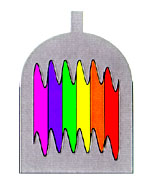
Earth Science: Geology, the Environment, and the UniverseChapter 15: Physical OceanographyProblem of the WeekThe Deep Blue Sea Blue skies, green grass, red roses, orange oranges, yellow canaries, and multicolored rainbows–every moment of every day, our eyes are bombarded with a plethora of color sensations. How is it that we see them all? What makes an object appear a particular color? Have you ever asked these questions? Most of us take colors for granted, but in this problem you will explore the physics of color. Look at the diagram on page 396 of your text. As you can see, light does not penetrate depths much past 150 meters. This has to do with the wavelength of light. White light is made up of all wavelengths of light. If you were to shine white light into a prism, you would see all the colors of the rainbow, somewhat like you see in the diagram on page 396. Different wavelengths produce various colors. As a result of the various energies of the wavelengths, you get the results in the diagram. As you can see, what we call the "deep blue sea" is mostly black.
Here are your results:
The Problem: Light can be reflected, absorbed, or transmitted. Armed with this information, the results of the experiment, and the diagram on page 396 (Figure 15-14) in your text, answer these questions:
|  |
















